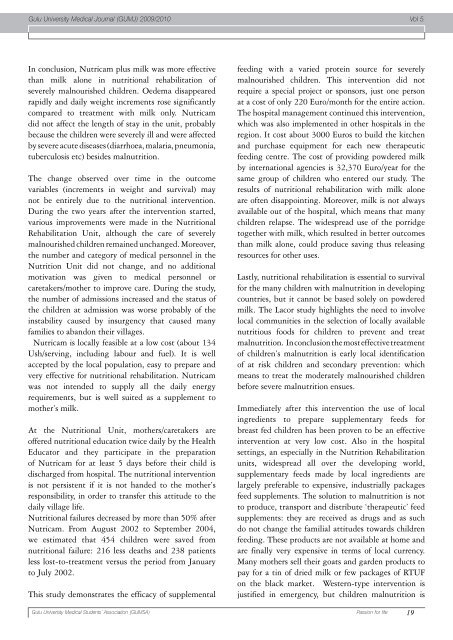GULU UNIVERSITY MEDICAL JOURNAL
GULU UNIVERSITY MEDICAL JOURNAL
GULU UNIVERSITY MEDICAL JOURNAL
You also want an ePaper? Increase the reach of your titles
YUMPU automatically turns print PDFs into web optimized ePapers that Google loves.
Gulu University Medical Journal (GUMJ) 2009/2010 Vol 5.<br />
In conclusion, Nutricam plus milk was more effective<br />
than milk alone in nutritional rehabilitation of<br />
severely malnourished children. Oedema disappeared<br />
rapidly and daily weight increments rose significantly<br />
compared to treatment with milk only. Nutricam<br />
did not affect the length of stay in the unit, probably<br />
because the children were severely ill and were affected<br />
by severe acute diseases (diarrhoea, malaria, pneumonia,<br />
tuberculosis etc) besides malnutrition.<br />
The change observed over time in the outcome<br />
variables (increments in weight and survival) may<br />
not be entirely due to the nutritional intervention.<br />
During the two years after the intervention started,<br />
various improvements were made in the Nutritional<br />
Rehabilitation Unit, although the care of severely<br />
malnourished children remained unchanged. Moreover,<br />
the number and category of medical personnel in the<br />
Nutrition Unit did not change, and no additional<br />
motivation was given to medical personnel or<br />
caretakers/mother to improve care. During the study,<br />
the number of admissions increased and the status of<br />
the children at admission was worse probably of the<br />
instability caused by insurgency that caused many<br />
families to abandon their villages.<br />
Nutricam is locally feasible at a low cost (about 134<br />
Ush/serving, including labour and fuel). It is well<br />
accepted by the local population, easy to prepare and<br />
very effective for nutritional rehabilitation. Nutricam<br />
was not intended to supply all the daily energy<br />
requirements, but is well suited as a supplement to<br />
mother’s milk.<br />
At the Nutritional Unit, mothers/caretakers are<br />
offered nutritional education twice daily by the Health<br />
Educator and they participate in the preparation<br />
of Nutricam for at least 5 days before their child is<br />
discharged from hospital. The nutritional intervention<br />
is not persistent if it is not handed to the mother’s<br />
responsibility, in order to transfer this attitude to the<br />
daily village life.<br />
Nutritional failures decreased by more than 50% after<br />
Nutricam. From August 2002 to September 2004,<br />
we estimated that 454 children were saved from<br />
nutritional failure: 216 less deaths and 238 patients<br />
less lost-to-treatment versus the period from January<br />
to July 2002.<br />
This study demonstrates the efficacy of supplemental<br />
feeding with a varied protein source for severely<br />
malnourished children. This intervention did not<br />
require a special project or sponsors, just one person<br />
at a cost of only 220 Euro/month for the entire action.<br />
The hospital management continued this intervention,<br />
which was also implemented in other hospitals in the<br />
region. It cost about 3000 Euros to build the kitchen<br />
and purchase equipment for each new therapeutic<br />
feeding centre. The cost of providing powdered milk<br />
by international agencies is 32,370 Euro/year for the<br />
same group of children who entered our study. The<br />
results of nutritional rehabilitation with milk alone<br />
are often disappointing. Moreover, milk is not always<br />
available out of the hospital, which means that many<br />
children relapse. The widespread use of the porridge<br />
together with milk, which resulted in better outcomes<br />
than milk alone, could produce saving thus releasing<br />
resources for other uses.<br />
Lastly, nutritional rehabilitation is essential to survival<br />
for the many children with malnutrition in developing<br />
countries, but it cannot be based solely on powdered<br />
milk. The Lacor study highlights the need to involve<br />
local communities in the selection of locally available<br />
nutritious foods for children to prevent and treat<br />
malnutrition. In conclusion the most effective treatment<br />
of children’s malnutrition is early local identification<br />
of at risk children and secondary prevention: which<br />
means to treat the moderately malnourished children<br />
before severe malnutrition ensues.<br />
Immediately after this intervention the use of local<br />
ingredients to prepare supplementary feeds for<br />
breast fed children has been proven to be an effective<br />
intervention at very low cost. Also in the hospital<br />
settings, an especially in the Nutrition Rehabilitation<br />
units, widespread all over the developing world,<br />
supplementary feeds made by local ingredients are<br />
largely preferable to expensive, industrially packages<br />
feed supplements. The solution to malnutrition is not<br />
to produce, transport and distribute ‘therapeutic’ feed<br />
supplements: they are received as drugs and as such<br />
do not change the familial attitudes towards children<br />
feeding. These products are not available at home and<br />
are finally very expensive in terms of local currency.<br />
Many mothers sell their goats and garden products to<br />
pay for a tin of dried milk or few packages of RTUF<br />
on the black market. Western-type intervention is<br />
justified in emergency, but children malnutrition is<br />
Gulu University Medical Students’ Association (GUMSA) Passion for life 19


